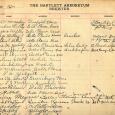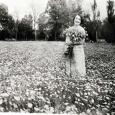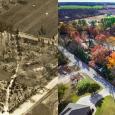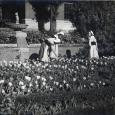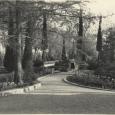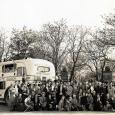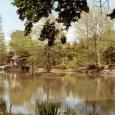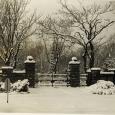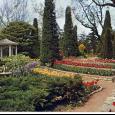
Bartlett Arboretum - Est. 1910
Barely a century ago - before generations of families came to love Bartlett Arboretum, before it became hallowed ground for nature lovers - its land was a treeless, undistinguished expanse of Kansas prairie. Indians camped along what became known as the Euphrates Creek, and only a rare willow or cottonwood sapling was able to take root.
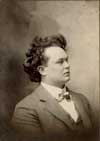 But in 1910, Dr. Walter E. Bartlett - a physician, naturalist and civic leader in the south-central Kansas town of Belle Plaine - had a vision and acquired 15 acres on the edge of town. He liked the terrain and thought its soil and water flow would be ideal for growing trees even though not much more than a tiny creek ran through the property.
But in 1910, Dr. Walter E. Bartlett - a physician, naturalist and civic leader in the south-central Kansas town of Belle Plaine - had a vision and acquired 15 acres on the edge of town. He liked the terrain and thought its soil and water flow would be ideal for growing trees even though not much more than a tiny creek ran through the property.
One of Dr. Bartlett's first projects was to build a dam, dredge the slough and create a larger lake, which became a haven for waterfowl - one of his particular interests. The plot was registered under the Federal Wild Fowl License and became known for wild geese, ducks and pelicans. It endured until the encroachment of civilization no longer made it feasible.
In this part of the country early in the century, tree-lined parks were a rarity. Most people regarded trees as simply places to seek shade, but they became Dr. Bartlett's absorbing interest. He lined walkways and drives and stream banks with all kinds of indigenous trees.
Dr. Bartlett also saw the property's potential to serve Belle Plaine's need for a park and athletic facilities. He built a baseball diamond complete with a grandstand.  He also offered an athletic field, a quarter-mile running track and facilities for trap shooting.
He also offered an athletic field, a quarter-mile running track and facilities for trap shooting.
"The baseball park was a great center of attraction for the town as this was in that era when baseball was the all-American pastime in small towns," says Dr. Bartlett's granddaughter, Mary Bartlett Gourlay.
The land, which became known as Bartlett Park, was used by Belle Plaine High School until it could build its own athletic field more than a decade later.
Though Dr. Bartlett continued to develop the park until his death in 1937, the project never was more than an avocation for the busy doctor. For his son, Glenn, however, it became a way of life.
The Bartlett tradition
Growing up, Glenn Bartlett was the inspiration for his father's interest in providing Belle Plaine with sporting facilities. He excelled in high school and college athletics. He also shared his father's passion for trees and helped him create the park. Glenn eventually became a professional landscape architect and horticulturist.
As a company commander in the 1st Division in France during World War I, Glenn was introduced to French gardens 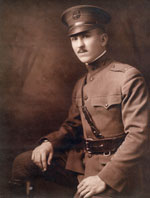 and landscapes, particularly as he studied aerial photographs for tactical operations. He later became a student at Toulouse University where he grew acquainted with certain trees common to French gardens. He also studied the Palace of Versailles gardens outside of Paris. What impressed Glenn was that the gardens grew out of an area that once was filled with sand dunes and marshes. He compared the transformation to the much smaller transformation in his hometown. It inspired him to create something of greater beauty and horticultural significance.
and landscapes, particularly as he studied aerial photographs for tactical operations. He later became a student at Toulouse University where he grew acquainted with certain trees common to French gardens. He also studied the Palace of Versailles gardens outside of Paris. What impressed Glenn was that the gardens grew out of an area that once was filled with sand dunes and marshes. He compared the transformation to the much smaller transformation in his hometown. It inspired him to create something of greater beauty and horticultural significance.
While completing post-graduate work at Columbia University in New York, Glenn encountered Belle Plaine native Margaret Meyers. The two became reacquainted and married in 1924.
Margaret was an artist, a fashion designer for magazines and a university instructor. She also was a noted flower arranger and garden club organizer.
Mary Gourlay says what is most important about her mother is "she was as enthusiastic, devoted and accomplished 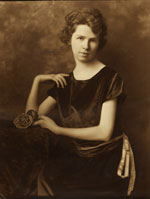 as was her husband in what became their common goal. It can be said that only through the unusual combination of their many necessary talents and attributes and unrelenting pursuance of purpose could such a jewel as the Bartlett Arboretum ever have been created in this region."
as was her husband in what became their common goal. It can be said that only through the unusual combination of their many necessary talents and attributes and unrelenting pursuance of purpose could such a jewel as the Bartlett Arboretum ever have been created in this region."
Glenn and Margaret forested their growing tree museum with varieties of nonindigenous trees that couldn't be found anyway else in Kansas. They dredged dirt from the lake, which came to be known as Euphrates Creek, to build islands. They constructed bridges that initially elicited criticism from the town's naysayers who thought them frivolous.
Eventually, though, the Bartletts came to have the only mature arboretum between the Mississippi River and the Rocky Mountains. The Bartlett Arboretum name was established as were celebrated community traditions such as Tulip Time, when they showed off 40,000 bulbs. The Bartletts opened the grounds for everyone from school groups to brides who made memories and came to regard the Arboretum as their own.
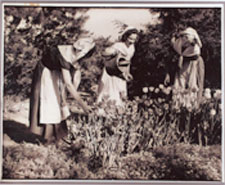
Glenn Bartlett died in 1976 and Margaret died in 1990 at the age of 95. The Bartlett daughters, Glenna and Mary, along with Mary's husband, Bob Gourlay, continued operating the Arboretum until 1995. Finally, in 1997, they decided to sell it.
"Fortunately," says Mary Gourlay, "this cute little blonde elf, Robin Macy, came knocking at the door. We didn't lose an arboretum, we gained another daughter."

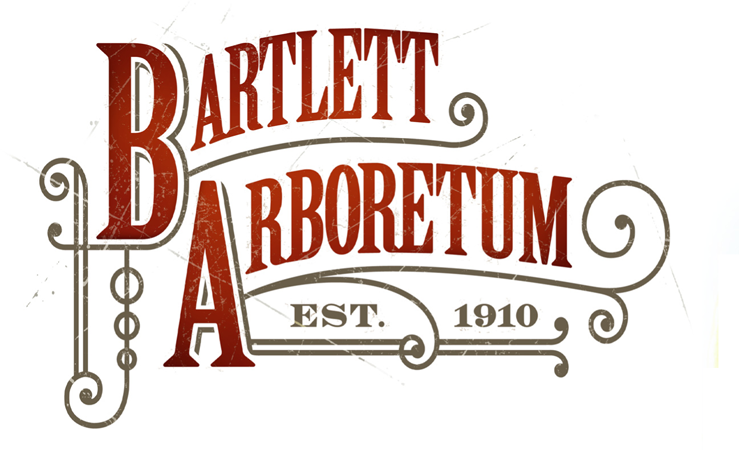 Bartlett Arboretum > Reflect > History
Bartlett Arboretum > Reflect > History
